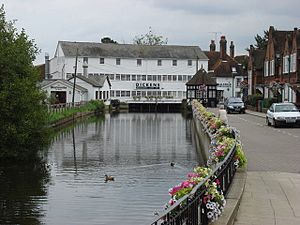Samuel Courtauld (industrialist) facts for kids

Samuel Courtauld (born 1793 – died March 22, 1881) was a very important British businessman. He helped his family's company, Courtaulds, grow into the biggest textile company in the world. Textiles are fabrics and clothes.
Contents
Meet the Courtauld Family
Samuel Courtauld was the oldest son of George Courtauld. His father started a company called George Courtauld and Co. The Courtauld family came from Huguenot refugees. These were French Protestants who moved to London to escape religious persecution.
For many years, the family was known for making beautiful things from metal. They were skilled metalsmiths, working with both silver and gold.
Samuel's father, George, changed things up. First, he started a business making textiles instead of metal items. This textile business became very famous. Today, when people think of the Courtauld family, they usually think of fabrics. In the 1700s, they were famous for silver. In the 1800s, it was silk and crepe. Later, in the 1900s, they made man-made fabrics.
Second, George Courtauld became a strong Unitarian. This is a type of Christian faith. Samuel Courtauld followed his father in both his business choices and his faith.
Samuel Courtauld also adopted a girl named Louisa Ruth Lowe (her maiden name was Harris). Her mother passed away shortly after Louisa was born. When Samuel died in 1881, Louisa inherited his large estate, Gosfield Hall, and much of his money.
Building a Textile Business
The Courtauld textile business began in 1794 in a place called Pebmarsh in Essex, England. At first, they were "throwsters." This means they made yarn by twisting fibers together. Later, they focused on weaving special fabrics like silk and crepe.
Samuel's father, George, and his cousin, Peter Taylor, built the business for twenty years. But after the Napoleonic Wars ended, things got tough. There was a lot of competition from other countries. In 1816, Samuel's father decided to retire. He gave his part of the business to his son, Samuel. This decision really helped the company grow.
After a few years, Samuel got the business back on track and making money. He felt ready to expand and try new things. In 1818, Samuel Courtauld built two more factories, called mills, in Halstead and Bocking.
In 1824, the Halstead Mill was sold. But in 1825, Samuel put a steam engine in the Bocking mill. This was a big step forward! Steam engines made it possible to power machines much faster. He also made a deal to convert the Halstead mill for silk production.
The new technology was important, but the mills still needed many workers. Most of these workers were young women. Even in 1838, over 92% of the people working in the mills were female.
In 1828, Samuel brought his brother, George Courtauld II, into the company. As the business grew, more partners joined. George Courtauld helped turn the company from a small local business into a major player in the textile industry. It became famous across the country and even around the world.
Samuel's Other Interests
Samuel Courtauld used his growing wealth to support causes he cared about. He was a strong supporter of the Whigs, a political group. He backed the important Reform Act, 1832, which changed how people could vote in Britain. He also gave money to the Anti-Corn Law League. This group wanted to lower food prices by changing trade laws.
As a dedicated Unitarian, he also joined a campaign by Nonconformist groups. They protested against having to pay "church rates" to support Anglican churches.
By 1850, Samuel Courtauld was very successful in business and finance. He was a rich man. However, his wealth could not help with his increasing deafness.
In 1854, Samuel bought Gosfield Hall. This was a large country house built in 1545, located near Halstead. Courtauld spent a lot of time, effort, and money to fix up the house and its large estate. He wanted it to be a grand home for a wealthy gentleman. Today, the house is a protected historic building. But Samuel was so dedicated to his business that he never fully retired to enjoy his beautiful home.
He continued to work actively in his company until just before he passed away in March 1881.
A Lasting Legacy
The huge wealth Samuel Courtauld created allowed later members of his family to do amazing things. They became supporters of the arts and gave money to good causes.
Some important family members who came after Samuel include his great-nephews:
- Samuel Courtauld (1876–1947): He became the head of Courtaulds in 1921. But he is perhaps best known for starting the Courtauld Institute of Art in London. This is a famous place for studying art.
- Sir Stephen Courtauld MC (1883–1967): He also loved art and, like the earlier Samuel, was good at restoring country houses. In 1933, he started working on Eltham Palace in south-east London. He and his wife lived there until 1944.
Images for kids
-
The Courtauld Silk Mill in Halstead, Essex


